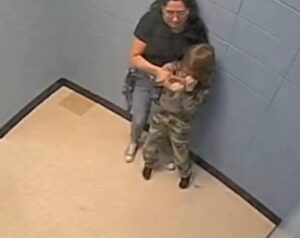Having previously prohibited several forms of physical restraint to control disruptive students, the Fairfax County School Board approved in December a policy that banned seclusion — isolating students in a place where they are physically prevented from leaving. As an alternative, teachers would use conflict resolution, de-escalation, and prevention.
What could possibly go wrong?
For starters, the school system promised to train staff on alternative approaches to dealing with highly disruptive students. But now that students are returning, post-COVID, to school buildings, staff training has been limited to online sessions, reports Inside NoVa.
But that’s a temporary problem. Eventually, staff will receive better training. Here’s what can happen when you mainstream students with severe emotional-control issues:
“The fact is, when it takes five of us to even physically keep a student in an area that’s safe, then that’s not worth the injury to staff,” special education teacher Cheryl Sandford told Inside NoVa. “No one is going to stand there and just get bitten or hit repeatedly, or be given a concussion because a chair was thrown at their head.”
In the 3½ years since she started working at Key Center, a Fairfax public school for students with severe disabilities, Sandford said she has sustained four concussions caused by students’ actions. Several of her staff members have also had to have stitches from students biting or throwing things at them. So, there is a good reason, Sandford said, why restraint and seclusion practices are used.
It’s possible that the use of physical restraint and isolation are overused. Inside NoVa cites hearsay instances when students were being restrained for yelling, breaking a pencil or refusing to step down. But it’s easy for parents of disruptive children to demand special consideration for their children when they’re not the ones coping with violent emotional outbursts and when it’s not their children whose education is being short-changed because a mainstreamed student with disabilities is commandeering the teacher’s attention.
Here is the crux of the problem. Parents of children with disabilities are insisting that their children be mainstreamed, and then they insist that schools, teachers and classrooms twist themselves into knots to accommodate their outbursts. The needs of regular students are sacrificed to meet the needs of the misbehaving students.
According to Virginia Department of Education data, between 14% and 15% of students in Fairfax schools are classified as having a disability. But the number classified as autistic tripled between 2005-06 and 2018-19 to 1,915. Some autistic students can be mainstreamed successfully, but many require special settings and teachers trained in their special needs. In severe cases, they should be transferred to special facilities.
How many concussions does a teacher have to receive before someone realizes that something’s not working?
Once upon a time, Fairfax County had one of the best public school systems in the country. It’s certainly one of the most expensive. Between the school board’s assault on Asian-American admissions into the Thomas Jefferson High School for Science and Technology, its implementation of critical race theory, its mainstreaming of students with disabilities, and its reliance upon “de-escalation” to maintain order in the classroom, Fairfax schools seem to be to be heading in the wrong direction.
But I’m a dinosaur. I come from an era when certain kinds of behavior simply were not tolerated. For a couple of years during my middle-school years, I probably spent half my weekends in Saturday-morning detention for talking in class. My teachers had this antiquated idea that I should not be allowed to interfere with their teaching. Maybe I’m wrong. Maybe, in defiance of more than 2,000 years of experience, Progressives have invented entirely new ways of conducting classes that don’t involve punishing anybody. Time will tell.



